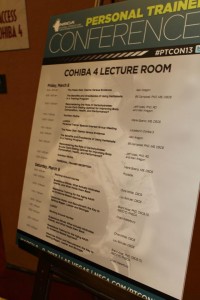
March 20, 2013
NSCA Personal Trainer Conference 2013 Recap: Part 2

Day 2 of the 2013 NSCA Personal Trainer Conference, held on Saturday, March 9, was as eventful as Day 1 (for a full review of Friday’s events, see my previous post). For me, it was even more so. I presented twice: at 9 am and again at 2 pm. Given my speaking schedule as well as the fact that I had a number of NSCA-related meetings throughout the day, I unfortunately missed out on several sessions that I really wanted to see including presentations by Lou Schuler, Nick Winkelman, and Martin Rooney. Nevertheless I was able to attend a number of excellent lectures. Here’s the lowdown.
First session of the day was presented by Jim Kielbaso, a top-level strength coach who specializes in training athletes. Given Jim’s background, his topic was very appropos: “Should You be Training Your Personal Training Clients Like Athletes?” Jim is a very polished speaker and his lecture was peppered with personal anecdotes from working with numerous players in the NFL and NBA. As Jim noted, most people couldn’t care less about gaining extra few inches on their jump height or decreasing their sprint time by a couple of seconds. All they want is to look better and be healthier. The take-home message here was that you should never inflict your own biases when training a client. In this regard, the fitness goals of a stockbroker, truck driver, and housewife will invariably be different than that of an elite athlete. Accordingly, they will require a different training approach than if you were working with Michael Jordan.
Next up, my session on “The Science of Squatting.” Squatting biomechanics has become one of my fitness hobby-horses. In 2010, I published an article in the Journal of Strength and Conditioning Research titled, Squatting kinematics and kinetics and their application to exercise performance.” The article extensively reviewed the literature on squats, and made practical recommendations for optimal performance. Subsequently, I wrote several articles for NSCA publications on the controversy over deep squats, including a point-counterpoint position statement in a recent issue of the Strength and Conditioning Journal. My lecture at the Personal Training Conference covered a variety of topics. I began by detailing the applied anatomy and kinesiology for each joint involved in the squat, and then delved into an array of performance-related issues including bar placement, gaze, stance, knees-over-toes, and of course, squat depth. A big debt of gratitude to Bret Contreras and Alan Aragon for introducing me–the dual introduction was an NSCA first. I was humbled by their sentiments as they are two of the people I respect most in the field. Here is a clip from my presentation.
embedded by Embedded Video
Following my presentation, I went to check out the lecture by Dr. Brent Alvar–one of the world’s leading strength and conditioning researchers–who spoke about evidence-based resistance training. Brent is not only a good friend, but he is also one of my mentors. He serves as the chairperson of my PhD dissertation committee, and has furthered my advancement as a research scholar. I owe him a huge debt of gratitude. In this lecture, Brent focused on training elderly adults as a means to discuss evidence-based practice. What impresses me most about Brent is that he isn’t just a lab geek. Rather, he has held positions as a personal trainer, strength coach, facility operator, and pretty much every other job you can think of in the field. The insight into practical application was readily evident in his presentation. Brent outlined a systematic approach to program design, discussing how to begin with a review of literature and then apply the information to the individual client by using logic and experience. As Brent made clear, a well-designed regimen will always be a blend of science and art; but you can’t be an artist without knowledge of the existing evidence.
The final session I attended was given by Chad Waterbury. Chad’s presentation was titled, “Maximize Motor Unit Recruitment: the Key to Getting Bigger, Leaner and Stronger.” This was the first time I’d heard Chad speak and it’s no wonder he’s such a popular fitness pro. His delivery was smooth and he displayed a clear confidence in the material. He provided definitive opinions on the best methods for maximizing motor recruitment, and discussed how this related to optimizing strength, power, and endurance. He concluded the presentation by explaining ways to incorporate his methods into program design, delving into the specifics of sets, reps, and frequency.
Summing up, this was an incredible conference in every facet. Big thanks to the NSCA for putting on such a well-run event. Looking forward to the National Conference in July…back in Vegas 🙂
Cheers!
Brad
No Comments
No comments yet.
RSS feed for comments on this post.
Sorry, the comment form is closed at this time.





 Entries (RSS)
Entries (RSS)



